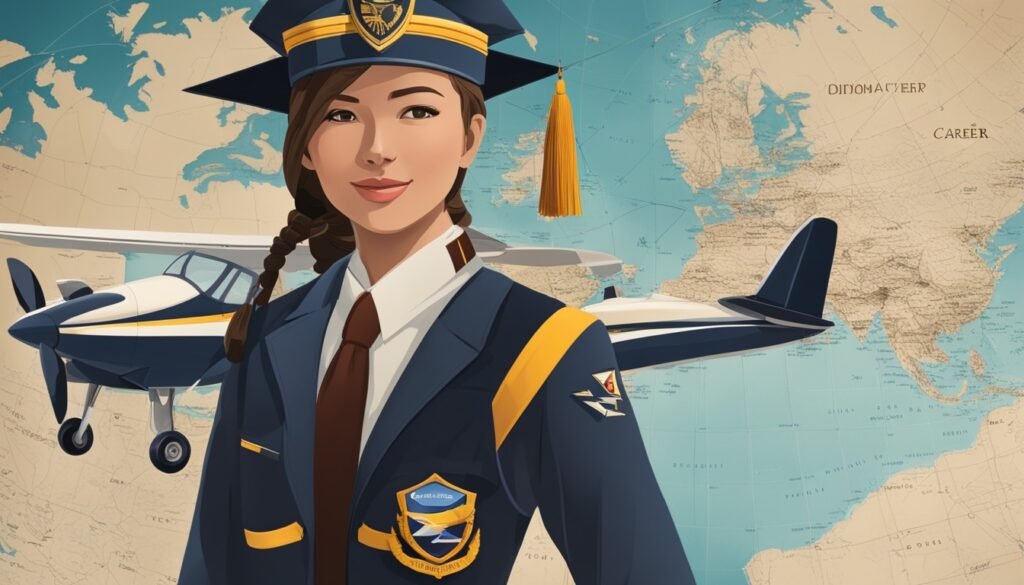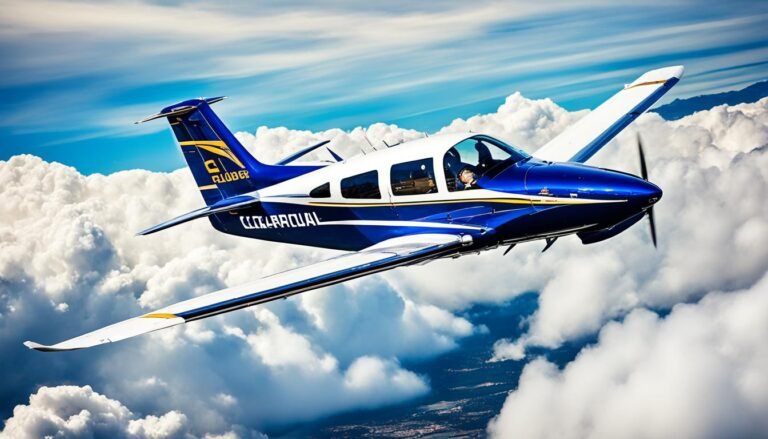Become a Pilot After 12th: Your Step-by-Step Guide

Have you ever dreamt of flying high in the sky, feeling the excitement of being a pilot? Wondering how to make that dream real, especially if you’re a student in India after 12th grade? You’re in luck.
This guide will teach you how to become a pilot step by step. You’ll learn about the requirements, the training, and everything you need to start your career in aviation.
Some people think becoming a pilot is too hard. But with a good plan and the right info, you can make it. So, if you’re excited about being a pilot after 12th grade, let’s begin your journey.
Key Takeaways:
- Understanding the step-by-step process of becoming a pilot after 12th grade in India
- Evaluating the eligibility requirements and educational foundations needed for pilot training
- Exploring the different stages of pilot training, from ground school to practical flight experience
- Understanding the licensing process and the milestones to achieve for a successful career as a pilot
- Discovering the various career opportunities and growth prospects in the field of aviation
Understanding the Basics of a Pilot’s Profession
Defining the Role of a Pilot
A pilot is key in the flight world. They safely fly planes, take care of people and goods. Pilots are smart and skilled, able to fly in all weather.
Different Types of Pilot Roles and Responsibilities
In aviation, pilots do many jobs. Commercial pilots fly big planes. They keep passengers safe. Private pilots fly smaller planes for fun.
Pilots also work in the military or teach flying. They do safety checks, fly the plane, follow routes, and talk to air traffic. They make sure rules are followed.
The Allure of a Pilot’s Life: Prospects and Rewards
Being a pilot is thrilling. They travel, see the world, and love their job. Flying a plane is a big achievement.
More pilots are needed as more people fly. This means lots of job chances. Pilots earn well, have good benefits, and feel proud of helping others travel.
Evaluating Eligibility and Setting Educational Foundations
To become a pilot, you must meet specific requirements and build a solid education base. Completing the 12th grade with a science stream is a must in India. This means you should know physics and math well.
Choosing a science stream after the 12th grade helps a lot. It teaches you about flight and airplanes. You learn how planes work through physics. Math helps you figure out where to go and how to get there safely.
For pilots, knowing physics and math is key. It helps a lot when they start their training. Understanding these subjects can make learning to fly easier.
Remember, becoming a pilot has certain education needs. A 10+2 grade from a known school or college is a must. Check what the pilot program you want needs. Make sure you meet all their educational rules.
In short, picking the science stream in your last years of school, especially physics and math, is vital for starting a pilot career. By taking the right courses and focusing on these key subjects, you can do well in your studies. This helps you get ready for flying planes for a living.
How to Become Pilot After 12th: A Detailed Exploration
After finishing the 12th grade, aspiring pilots must follow several steps. These steps will guide you towards achieving your dream of flying. Through this exploration, you will gain insights that are valuable. These insights are essential for anyone wanting to become a pilot.
Charting the Course: Steps Right After 12th Grade
Upon finishing the 12th grade, selecting the right path is crucial. It’s key to explore and pick a pilot training program that fits your goals. Make sure to consider the institute’s reputation and its training facilities. Also, look at the curriculum it offers.

Choosing the program comes next. Make sure you meet their requirements. This usually includes getting a Class 1 Medical Certificate. Ensure you’re in good health as per DGCA’s standards.
Entrance Exams and Preparation Strategies
Before enrolling, you might need to pass entrance exams. These test your knowledge and skills for flying. Prep by studying physics and math. Also, work on your problem-solving.
Creating a study plan and talking to those in the field can help. Practice with sample papers. Join mock exams to get used to the test style.
Understanding the DGCA and its Regulations for Pilots
The DGCA handles aviation rules in India. Knowing their rules is a must for aspiring pilots. These rules guide pilot training and flight conduct.
Follow DGCA’s rules as you train. This means getting necessary licenses and adhering to safety standards. Use resources and advice from experienced pilots. This ensures you’re on track.
Follow these steps to start an exciting career in piloting. It takes hard work and a love for flying. Stay dedicated, keep learning, and pursue your dream relentlessly.
Selecting the Right Aviation Academy and Flight Training
Choosing the right aviation academy and flight training program is key to a successful pilot training journey. The academy you pick will help shape your skills, knowledge, and overall growth as a pilot. Here are some tips for choosing the best flight school:
- Accreditation: Make sure the aviation academy is accredited by relevant aviation authorities. This shows the academy meets important standards for quality and safety.
- Reputation: Find out what people in the industry and other pilots think of the academy. Read reviews and talk to current and former students to understand the quality of training better.
- Facilities: Check that the academy’s facilities are up-to-date and well-kept. Look for things like flight simulators, training planes, and resources that make learning to fly feel real.
- Cost: Think about the cost of the training program, which includes tuition, housing, and other expenses. Make sure it’s a good value for your money and fits your budget.
In India, there are several top institutions that provide excellent flight training. Some of the leading aviation schools in the country are:
“Indian Aviation Academy: Set in New Delhi, this academy is known for its advanced facilities and skilled instructors. It offers various programs to ensure student pilots get the best training and support.”
“Indira Gandhi Rashtriya Uran Akademi: Located in Rae Bareli, Uttar Pradesh, this academy is highly regarded. It’s famous for its top-notch faculty and wide-ranging training that prepares students well for aviation careers.”
| Aviation Academy | Location | Programs Offered |
|---|---|---|
| Indian Aviation Academy | New Delhi | Pilot Training, Aircraft Maintenance, Cabin Crew Training |
| Indira Gandhi Rashtriya Uran Akademi | Rae Bareli, Uttar Pradesh | Pilot Training, Flight Instructor Courses |
Always pick a flight school that matches your dreams and the kind of pilot career you want. Visit the academies, go to their information sessions, and talk to students and instructors. Choosing the best aviation academy and flight training program is a critical step toward achieving your pilot dream.
Navigating Theoretical Knowledge: Ground School and Beyond
In pilot training, knowing theory is vital for safe flying. New pilots learn a lot in ground school. They study many subjects to be ready for the skies.
Key Ground School Subjects for Aspiring Pilots
Ground school teaches a lot to future pilots. They learn about aviation, weather, navigating, and aircraft systems, among other things.
- Aviation Theory: This covers the basic ideas of flying. Pilots study why planes fly and how they move. Knowing this helps them fly safely.
- Meteorology: Pilots learn about weather. They know about storms and windy conditions. This lets them plan safer flights.
- Navigation: This teaches pilots how to find their way. They use maps and GPS to stay on track. Accurate navigation is key to a successful flight.
- Aircraft Systems: Pilots get to know their planes inside out. They learn about controls and safety equipment. This ensures that their aircraft work well and are safe to fly.
Ground school gives pilots a good understanding of flight theory. It helps them make the right choices when flying.
Importance of Theoretical Hours in Pilot Training
Learning theory is the start of every pilot’s career. It makes sure pilots know how to fly safely. The study prepares them for the challenges of flying.
- Ensure Safety: Pilots must know the theory of flight to fly safely. They understand the weather and how to navigate. This helps them avoid risks and handle emergencies.
- Comply with Regulations: Aviation rules must be followed. By studying, pilots meet these rules. They become aware of what’s needed for safe flying.
- Enhance Decision-Making: Theory teaches pilots how to think on their feet. They learn to solve problems and manage risks. This sharpens their decision-making skills in the air.
Spending time on theory is crucial for pilot success. It gives them the knowledge and mind frame to deal with the demands of flying.
| Ground School Subject | Description |
|---|---|
| Aviation Theory | Covers the fundamental principles and concepts of aviation, including aerodynamics, flight controls, and aircraft systems. |
| Meteorology | Focuses on the study of weather patterns and its impact on flight operations, including weather phenomena, atmospheric conditions, and weather interpretation. |
| Navigation | Teaches various techniques and skills required for accurate navigation, including map reading, radio navigation, and advanced navigation systems. |
| Aircraft Systems | Provides a comprehensive understanding of different aircraft systems and their components, including instruments, electrical systems, fuel systems, and emergency procedures. |
Accruing Flight Hours: The Practical Flight Training Experience
Getting practical training is key to becoming a pilot. It’s where you learn to really fly, not just from books. Practical flying is needed to be safe and good in the air.
Students go through different flight steps. They start with solo flights and move to flying farther away, with special tools, and handling problems. As they go forward, they get better at things like taking off, landing, controlling planes, and managing issues while flying.
Flight instructors help them learn in the air. Students get to use what they studied in real flights. This helps them make smart choices and stay alert, which are very important for pilots.
The lessons are well planned to cover everything about flying. They learn about checking planes, using systems, flying, talking in the air, looking at weather, and what to do in emergencies. This makes sure they know all they need to fly planes safely.
From Student to Pilot: The Licensing Process
After finishing your flight training and getting needed knowledge and experience, you move towards getting pilot licenses. These licenses are key for your aviation career.
Private Pilot License: The First Milestone
The Private Pilot License (PPL) lets you fly solo and with passengers. To get it, you need to meet flight hour, pass a written test, and do a flying test.
In your PPL training, you learn to fly, navigate, and handle emergencies. You also learn important aviation theory and rules.
Commercial Pilot License: The Gateway to an Aviation Career
After the PPL comes the Commercial Pilot License (CPL). This allows you to fly for money. You must pass more tests and get extra flight hours for the CPL.
With your CPL, you can fly for airlines, become a teacher, or work as a corporate pilot. It’s an important step in your pilot career.
Instrument and Multi-Engine Ratings for Expanded Horizons
Next, getting Instrument and Multi-Engine Ratings can help your career. These ratings give more knowledge and skills.
With an Instrument Rating, you can fly safely in bad weather. You learn about instruments and navigation.
The Multi-Engine Rating is for planes with more than one engine. It teaches you to fly bigger planes and be a better pilot.

| Licensing Process | License Type | Key Requirements |
|---|---|---|
| Private Pilot License | PPL | Flight hour minimums, written knowledge exam, practical examination. |
| Commercial Pilot License | CPL | Additional flight hours, written and practical exams. |
| Instrument Rating | IR | Advanced navigation techniques, instrument approaches, utilization of onboard instruments. |
| Multi-Engine Rating | ME | Training on multi-engine aircraft, proficiency in multi-engine operations. |
Ascent in Your Career: Opportunities and Growth as a Pilot
Your career as a pilot is more than flying. The aviation field has many opportunities. You can find growth in various aviation career paths.
Airline Pilots: Flying for airlines is a common dream. This path lets you fly all over, using different planes.
Corporate Pilots: Flying private jets for companies is another path. You get to see rare places and meet important people.
Flight Instructors: Teaching others to fly is rewarding. You help new pilots learn, growing the next generation.
Military Pilots: Military flying brings its own challenges. You might do combat, transport, or help with missions. It’s a way to serve, get high-level training, and improve your skills.
Many other paths exist too. The aviation field is vast, offering lots of jobs. As a pilot, you can grow a lot, leading in many areas of aviation.
Costs and Financial Planning for Pilot Training
To be a pilot, knowing the training and financial costs is key. You should plan your budget well to make your aviation career dreams come true.
Budgeting for Your Dream: The Cost of Training to be a Pilot
When you figure out pilot training costs, think about a few things. This includes:
- Tuition fees for flight schools and aviation academies
- Cost of ground school and theoretical training materials
- Flight instructor fees
- Cost of flight hours
- Examination and licensing fees
- Insurance and medical expenses
Remember, costs can change based on where you train, the program type, and your situation. Look into different places to train. This will help you pick what fits your budget and goals best.
Navigating Scholarships and Funding Options
If you need help with training costs, many options can assist you:
- Scholarships: Look into scholarships from different groups, like aviation schools. They help pay for training and give needed support. Research and apply for scholarships that fit your aviation dreams.
- Loans: Banks have loans for pilot training. These loans help you start your training and pay back the money slowly. Be sure to understand the loan rules before you decide.
- Military Programs: Military groups have programs for those who want to be pilots. These programs give good training and financial help.
- Personal Savings and Financial Planning: It’s smart to save money early and make a financial plan for your pilot training. Set a budget, save from your earnings, and look at how to invest. This will make sure you have the money you need for your dream.
Look into these options and plan your finances well. This will help you face the financial sides of pilot training and achieve your dream.
Conclusion
Becoming a pilot after 12th grade is exciting and fulfilling. It needs determination, dedication, and planning. We explained how to become a pilot step by step in this guide.
We talked about what a pilot does and their roles. We also mentioned the good parts of a pilot’s life. This includes the rewards and how to make it happen after high school.
Choosing a path, studying for exams, and following the rules are important. It’s also key to pick the right school and training. Knowing theory and hands-on flying are both necessary.
Getting your pilot licenses step by step is crucial. This includes a PPL and then a CPL. Ratings for flying different planes open more job opportunities for you.
Training to be a pilot can cost a lot, so planning your finances is key. There are scholarships and other ways to help with the costs. Keep your goals clear and start your flight journey. With hard work and good advice, you can make your flight dream come true.




